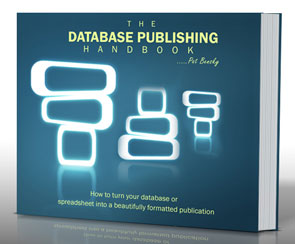
Tools to help with Database Publishing using RTF
(Rich Text Format)
Rich Test Format is a text tagging specieifcaiton that was developed by Microsoft more than 10 years ago. Its purpose is to provide a way to exchange files consisitng of text and graphics between applicaitons – primarily, Microsoft Word and other applicaitons. Most page layout programs are able to interpret RTF files, so it's a versatile format.
However, it's also quite a complex format – more complex than one of the newer tagging systems such as Quark or InDesign tags. But if you really need to be ablet to work with a program that doesn't support one of these newer systems, then RTF could be the answer for you.
One advantage of using RTF is that ou can create an entire document from scratch. This gives you tremendous flexibility in the creation of new documents.
The RTF format consists of control words which pass various infromation to the RTF reader (the program that is opening and displaying the file). These control words might tell the reader how to format some text (eg, use a particular stylesheet or set some text in bold), or they might pertain to the formatting of the document - eg the margin settings, document size, etc. The specification also uses curly braces and angle brackets to group the controls, commands and content within the document.
RTF Resources
|
Official r eference to the Rich Text Format.
|
Download a copy |
|
Book: RTF Pocket Guide
There are many formats for documents, and few are as difficult to parse as Rich Text Format (RTF), the internal format for Microsoft Word. Unlike structured formats such as XML and SGML, or even the less structured formats such as HTML or Troff, RTF reduces all styles, formats, fonts, etc., to pure presentational commands. It's filled with arcane, redundant, incomprehensible markup. Why use RTF then? Because we have to. Microsoft® Word is a ubiquitous application, and love it or hate it, we're stuck with it. So we frequently find ourselves having to deal with RTF files, either to convert to or from another format, or to make global changes. Additionally, there is little or no printed documentation for RTF. You can't always stop to search for the piece of information you need online--or take the time to wade through irrelevant or even erroneous online information. When you need to get to a solution quickly, the new RTF Pocket Guide is the book you'll want to have.
|
Get a copy from:
|

